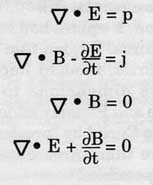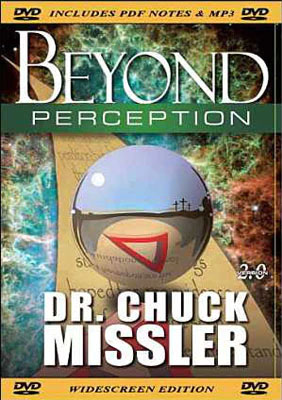Born into this world with two eyes, two ears, two arms, two legs and a wonderful data-crunching computer system in both halves of our brains, we humans develop a perception of space as small infants. We do not have to be told that the world we live in has three dimensions: length, width, and height. It is almost intuitively obvious.
The Greek philosopher Euclid (330-275 B.C.) put this down in a mathematical format we now call plane geometry-which ruled the world for the next 2000 years-almost like a religion! In grade school we all learned that the angles of a triangle must add up to 180 degrees, and that a straight line is the shortest distance between two points. A line had one dimension, a square had two, and a cube, three. Beyond that it was, for centuries, thought impossible for more dimensions to exist. Aristotle and Ptolemy added their weight to Euclid by "proving" that any more than three dimensions was "impossible."1
But of course for those who believed in God, there must be a fourth dimension. God would surely live there, thus He could watch everything that was happening in our 3-D world. Medieval art even accommodated this orthodoxy-paintings were flattened and two dimensional so the viewer could (sort of) see the world as God sees it.
Until the middle of the last century there was not much talk of a possible Fourth Dimension. But a sickly, brilliant mathematician-the second of six children born to a poor Lutheran pastor-Bernhard Riemann (1826-1866) blew the world apart when he proved mathematically that more than three dimensions were not only possible but also highly likely. In a brilliant lecture on June 10, 1854 this shy, mentally unstable young man toppled the Euclidean world order once and for all.
The Math of Hyperspace
Riemann had discovered what we now called "field theory," which connects forces in the universe with the geometry of space. The Pythagorean Theorem from the Greeks had shown that in a two-dimensional world where a and b are the short sides of a triangle and c is the hypotenuse, then a2 + b2 = c2. For a cube which had sides a, b, and c, the diagonal, d, inside the cube, crossing from one corner to another was given by a2 + b2 + c2 = d2. Well, it did not stop there, because from purely mathematical considerations Riemann could imagine an N-dimensional cube whose diagonal, z, was simply given by a formula with N terms on the left side, a2 + b2 + c2 + .... = z2. The math was easy, the implications were world-shaking.
As originally conceived, the "fourth dimension" was an additional spatial dimension, and not the fourth dimension now called "time." It was Einstein who stumbled upon Riemann's pioneering work and in 1905 put 3 plus 1 together and realized that material objects not only have length, width, and height, but they also endure in time. The fourth dimension was obviously time!
Newton's physics had imagined an absolute clock somewhere in the universe that kept the time for all bodies large and small, whether at rest or in motion. So strongly embedded were the old views that the average person on the street has not yet grasped the radical nature of Einstein's revolution. But now it is clear that space and time are part of an integrated whole-what we call the "space-time" continuum."
Time as well as space can be bent, shrunk or expanded-as can the other three dimensions of the world we live. But if few ordinary people grasp what Einstein had to tell us, Riemann's revolution has had an even greater, lasting effect on physics.
However, to talk about time as the fourth dimension is to jump over 50 years of fascinating history before 1905, when the obscure little man in the Swiss patent office changed the known world all over again.
Riemann's 1854 lecture was an instant success. The world was not flat and it was not necessarily even limited to three dimensions-there might be four-or even more! God was now crowded up into the higher levels of newly discovered "hyperspace." Riemann had been friends with Wilhelm Weber, who was experimenting with electric sparks, magnets and flowing currents-so Faraday and then Maxwell were ready to apply Riemann's work to what became the very successful model we now call "electromagnetic theory."

James Clerk Maxwell, for instance, showed that moving electric charges constitute what we call current flow and flowing currents produce magnetic fields. Light waves, radio waves, and x-rays all "obey" Maxwell's elegant equations: (Diag. 1)
The first equation says that electric lines of force begin and end on charges (such as electrons). The third equation tells us that there are (apparently) no magnetic monopoles-magnetic lines are closed loops. The second and fourth equations are vector equations actually representing three equations each, and they tell us how electric and magnetic fields are related to one another. Maxwell's four equations are actually eight. However if one adopts the mathematics of Riemann space, all eight equations can be written in the following form, called "tensor notation":
Fv = Av - vA
Fv = jv
The second equation says it all! It is this ability of Riemann geometry to simplify physics that is so appealing to scientists who always prefer elegance, beauty, symmetry and simplicity when attempting to explain the physical world. Introducing more dimensions, even though they can not be seen or directly measured, improves our ability to understand how the world works.
Georg Bernhard Riemann took ordinary "flat" geometry and crumpled it up, making spherical space which was positively curved, or saddle-shaped space with negative curvature. All this could now be beautifully described in the new short hand of tensors. Whole systems of simultaneous differential equations involving many dimensions could be written down and manipulated with ease.
Riemann showed that spaces could be multiply connected, as shown below. A small bug living in the flat world of the top sheet of paper could hypothetically encounter a "Riemann slit" in the fabric of his known world and inadvertently cross over into a "parallel" universe.
A strange cast of characters seized upon Riemann's ideas soon after his famous lecture. American psychic Henry Slade achieved notoriety in 1877 when Leipzig physics professor Johann Zollner rushed to the former's defense of magic parlor tricks and ghosts by claiming that what was impossible in our ordinary three-dimensional world was readily possible if a fourth dimension were added. Unfortunately, the ensuing uproar led more to popular turn-of-the-century science fiction, and an impetus for ESP and psychic research which continues to this day-more than to legitimate applications in physics. The greatest applications of Riemann's new geometry to physics had to wait half a century for Einstein and his successors.
"Flatland"
In 1884 the Christian headmaster of the City of London School, Edwin Abbott, wrote a wonderful novel about creatures who lived in an imaginary world called "Flatland."2 It was now immediately easy for ordinary people like you and me to imagine what it would be like living in a two dimensional world-on a flat sheet of paper-with occasional intrusions of "beings" from a higher three-dimensional "hyperspace." Even more fantastic science fiction now unfolded into being overnight and by the turn of the century the common man's perception of his world would never be the same.
If four dimensions are not only possible, but now certain, why not 5 or 10 or 26 dimensions? Indeed, if we jump from Einstein to the present time, that is precisely what has happened in modern physics. All this has taken place because introducing (mathematically) additional dimensions to the physical world "unifies" the laws, forces and fields of physics, and leads (usually) to simpler and more "elegant" ways of looking at the universe in which we live.
Discussion of hyperspace rapidly became very complex after Einstein-we must save that for another article. But let us note several things: It is indeed quite likely that the physical, material world we live in has many more than four dimensions.
Ten is a reasonable number to make our physics simple. Discussion of hyperspace still leaves the issue of where God now lives, since he was long ago excluded from the "fourth" dimension. Unfortunately some modern Christian apologists have implied that God is merely a higher-dimensional being, a cosmic giant who pokes his fingers into our world from time to time, alarming us with visions or miracles which we cannot fully understand. Is God a super being from another dimension?
I don't mean to imply that miracles, visions and UFO intrusions from higher dimensions do not occur! They most certainly occur and I believe they are all real extra-dimensional happenings. The point is: God is not made of matter, He is Spirit and spirit is something fundamentally different from matter.
There is an all-important point to keep in mind in our discussions of modern physics and that is that "God is a Spirit and those who worship Him must worship Him in spirit and in truth." (John 4:24) Spirit is not the same thing as matter!
We can talk endlessly about matter/energy, space and time in the created material world, but that still leaves a higher realm of God and his angels. Who are they and where do they live? What are the unseen worlds they inhabit? Beyond our amazing physical world is yet another realm where different laws apply and where time flows at a different pace.
To talk first of matter and now of spirit is also to go beyond the scope of this short introductory article. Suffice it to say, our knowledge and understanding of the physical world comes through the scientific method, which is based both on observations and on mathematical models that can be tested and verified by measurements and experiments.
The spiritual world is something we know about by personal revelation from our God.3 Most marvelous of all, God has created man to live simultaneously in the material and in the spiritual world. He wants us to be at home in two worlds-he wants us in His training program designed to prepare us for an amazing greater world which is to come.
The opening of doors for us to enter into other worlds was accomplished by the sacrificial work of Jesus Christ on the Cross-we live in a moral universe, and much more than physics is involved in the superhyperspace the Bible calls the "heavens."
"Since we have the same spirit of faith as he had who wrote, 'I believed, and so I spoke,' we too believe, and so we speak, knowing that he who raised the Lord Jesus will raise us also with Jesus and bring us with you into his presence. For it is all for your sake, so that as grace extends to more and more people it may increase thanksgiving, to the glory of God. So we do not lose heart. Though our outer nature is wasting away, our inner nature is being renewed every day. For this slight momentary affliction is preparing for us an eternal weight of glory beyond all comparison, because we look not to the things that are seen but to the things that are unseen; for the things that are seen are transient, but the things that are unseen are eternal."
2 Cor. 4:13-18
For further study, explore Chuck's briefing package Beyond Perception.
Notes:
- Michio Kaku, Hyperspace: A Scientific Odyssey Through Parallel Universes, Time Warps, and the 10th Dimension, Anchor Books Doubleday, New York. 1994. A wonderfully valuable and important book.
- Abbott, Edwin A., Flatland, 1884.
- For more on the limitations of science see http://www.ldolphin.org/scilim.shtml. Steps in the scientific method are outlined in http://www.ldolphin.org/SciMeth2.html, and http://www.ldolphin.org/reveln.html describes the nature of Biblical revelation in contrast with mere mystical experience and with data from science.






